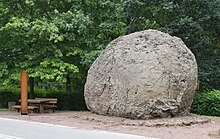Volcanic bomb

A volcanic bomb (formerly: ejector) is a pyroclast with a diameter of more than 64 mm that is ballistically ejected during a volcanic eruption . It has rounded forms; the external shape and surface show signs that the pyroclast had melted during formation and transport. In the older literature, any pyroclast thrown out on a ballistic pathway is considered a bomb. In the more recent literature, on the other hand, angular pyroclasts of this size class are referred to as volcanic blocks . Pyroclastic rocks, which consist of more than 75% volcanic bombs, are called volcanic agglomerates .
Characteristics


Volcanic bombs are by definition more than 64 mm in diameter, but can also reach several meters. Their shape is usually ovoid or spindle-shaped, as they rotate around their own axis during flight and when they cool down in the air. So-called bread crust bombs arise in particularly gas-rich and viscous ( silica-rich , "acidic") lava . The glowing liquid lava, which is abruptly transported into the pressure and temperature conditions of the earth's surface due to the high conveying speed, gasses violently during the ballistic flight. On the one hand, this enlarges the bubbles that are already in the material, and on the other hand, new ones are created. The tensions caused by the puffing up cause cracks to appear on the surface, which has already solidified in flight due to the rapid cooling, which give the lava lumps the appearance of a loaf of bread.
Due to their relatively high weight, the bombs fall to the ground in the vicinity of the volcano and therefore cause relatively little damage compared to other volcanic accompanying phenomena.
Occur

Volcanic bombs occur in almost all eruptive volcanic eruptions. Examples are the volcanic areas of Iceland or the volcanic areas of Italy . For example, specimens of volcanic bombs can be found on the Italian volcanic island of Vulcano at the summit of the Fossa . These are ejections from the eruption phase from 1888 to 1890. However, they were created by the heating of fragments of older volcanic rocks that had become viscous .
In Germany, for example, volcanic bombs are often found in the vicinity of the Laacher See and other eruption centers in the Vulkaneifel . A particularly large specimen of a volcanic bomb is on display in Strohn (see photo).
Others
The basis of the Olmec heads that arose around 2500 to 3000 years ago near the Mexican volcanic mountains of the Sierra de los Tuxtlas are probably volcanic bombs.
Web links
literature
- Roger Walter Le Maitre (Ed.): Igneous rocks. IUGS classification and glossary; recommendations of the International Union of Geological Sciences, Subcommission on the Systematics of Igneous Rocks. 2nd edition Cambridge University Press, New York 2002, ISBN 0-521-66215-X , 236 pp.
- Hans Pichler : Italian volcanic areas, vol. 3: Lipari, Vulcano, Stromboli, Tyrrhenian Sea (collection of geological guides; vol. 69). Gebr. Bornträger, Stuttgart 1981. ISBN 3-443-15028-4 .
Individual evidence
- ^ Geological Guides Collection, edited by Peter Rothe, Volume 60, H. Wolfgang Wagner, Friederike Kremb-Wagner, Martin Koziol and Jörg FW Negendank, Trier and the surrounding area, 3rd edition, Gebr. Bornträger Verlagsbuchhandlung, Stuttgart, 2012, page 311, ISBN 978-3-443-15094-5 .

